
By Brian Kakuk, Founder/Director - Bahamas Caves Research Foundation
June 17, 2011
Divers: Jill Heinerth and Brian Kakuk
Standby Divers: Paul Heinerth (Deep), Brett Gonzalez (Shallow), Gil Nolan (dry shallow)
Time: 13:38
Bottom Time: 19 minutes
Reaches Surface Time: 15:54
Total Time of Dive: 129 minutes
Maximum Depth: 310 feet
Total Decompression Time: 110 minutes
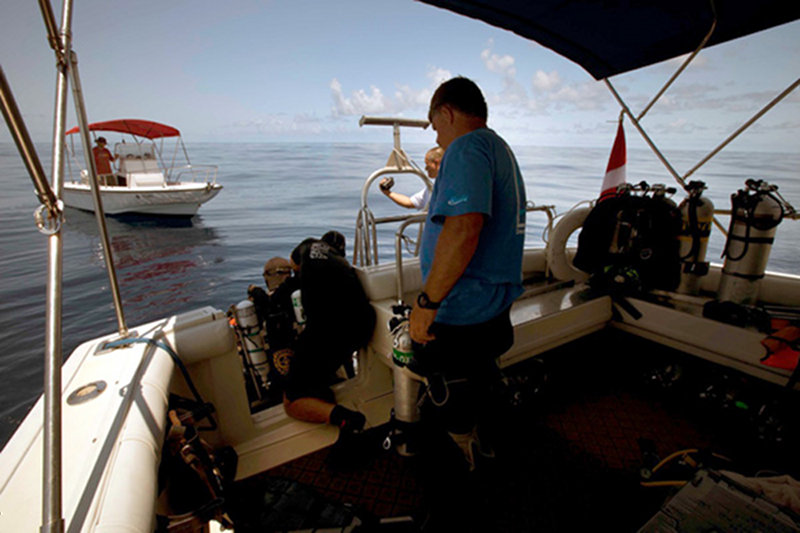
Brett Gonzalez assists Tom Iliffe with his bailout tanks as he prepares to dive on a beautiful flat sea. Alex Chequer stand by in a fast boat in case of emergency. Project DSO, Brian Kakuk, watches over the operation. Image courtesy of Jill Heinerth, Bermuda Deep Water Caves 2011 Exploration, NOAA-OER. Download larger version (jpg, 557 KB).
A strong, northwesterly wind forced our team to move to the southern end of the Bermuda today in the hope that we might find sea conditions suitable to conduct a 300+ foot dive on the edge of the Bermuda platform. Captain Graham steered the 36 foot boat through the continuous maze of coral heads, mostly invisible to the untrained eye until their caramel colored tops crashed through the surface of the water between the peaks of the swells.
Only 45 minutes after leaving the dock at Grotto Bay, Capt. Graham yelled out “now!” and the crew on board the Pourquoi Pas dropped an odd, missile shaped weight over the side. The weight was attached to 250 feet of nylon line which ended in a large white surface buoy. This would be the descent line to our research site and would mark the dive team’s location for the duration of the dive.
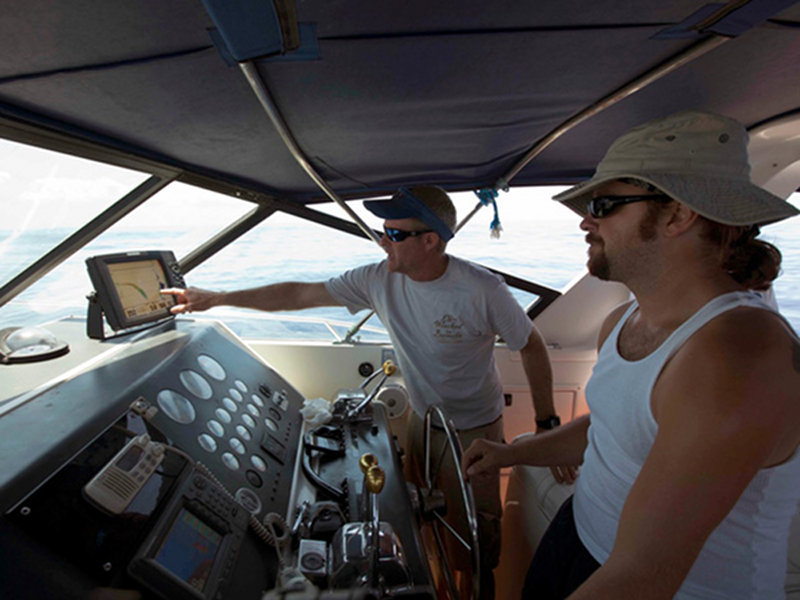
Captain Graham Maddocks and Brett Gonzalez select a steep drop on the bottom finder before deploying the mooring. Image courtesy of Jill Heinerth, Bermuda Deep Water Caves 2011 Exploration, NOAA-OER. Download larger version (jpg, 539 KB).
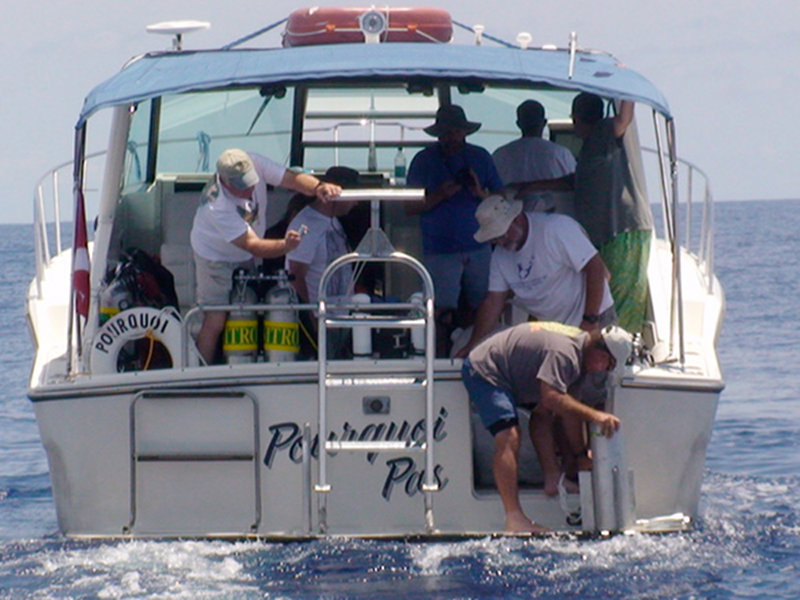
Brian Kakuk ready to deploy missile-shaped weight over the side. Image courtesy of Bermuda Deep Water Caves 2011 Exploration, NOAA-OER. Download larger version (jpg, 2.4 MB).
Moments later Jill Heinerth rolled face-first off the back platform, clad in more than 200 lbs. of rebreather, 3 stages, and camera equipment. I met Jill at a depth of 10 feet a few minutes later and we slowly descended down the line to the bottom. Visibility changed dramatically during our descent. We could only see 20 feet through the soupy, critter-filled water until we reached a depth of 130 feet, at which point we broke through into 100 foot visibility and 68 degree water. The descent line weight was sitting off to the side of a slight ledge at a depth of 215 feet with the bottom gradually sloping downward off into the distance.
As we reached the bottom two large, 4 foot long Amberjacks came rocketing at us, spastically circling, and as fast as they had arrived, they were gone. We continued down the slope trying to achieve our planned depth in the short amount of bottom time allotted. After swimming for 5 minutes, we reached a depth of 310 feet and began our photo and sampling work.
I was concentrating on gathering as many biological and geological samples as possible as we slowly worked our way back up the slope. Coming from the Bahamas, I was fascinated with many forms of life I had never seen before. Many unfamiliar soft corals, gorgonians and other bottom critters were scattered across the landscape. One of the most intriguing animals I saw was several large, white bodied, but red-spotted sea cucumbers. The red spots were large and round and the animal resembled an over-sized clown shoe. I tossed one of the shoes into a large zip lock bag and continued up the slope collecting gorgonians and rock samples as we went. I could keep track of Jill by the flurry of flashes coming from my left side as we moved up slope.
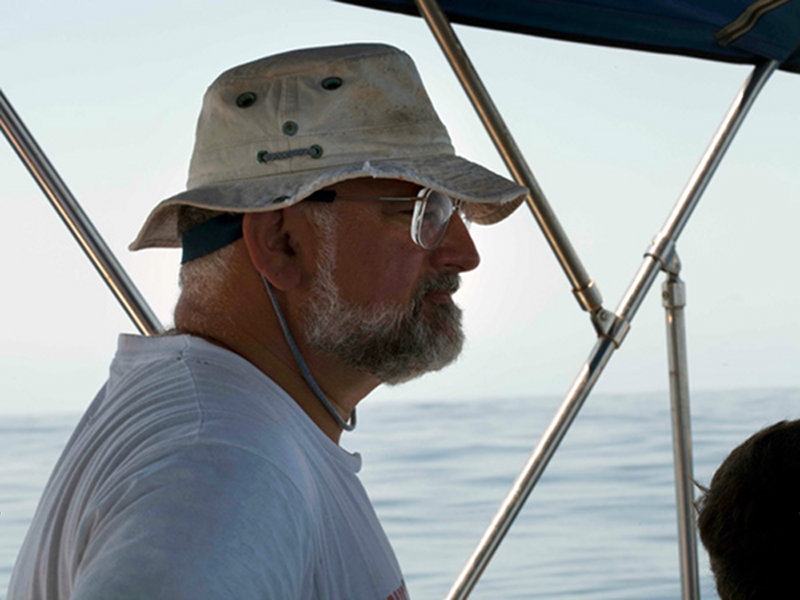
Safety diver and local Bermudian, Gil Nolan, keeps watch until the divers are ready to plunge. Image courtesy of Jill Heinerth, Bermuda Deep Water Caves 2011 Exploration, NOAA-OER. Download larger version (jpg, 414 KB).
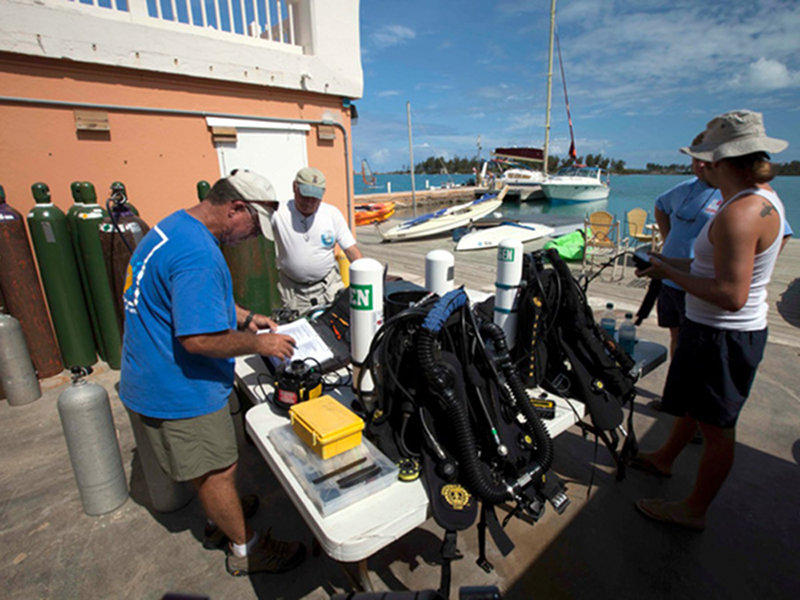
Brian Kakuk uses his pre dive check sheet to prepare his Megalodon CCR. Image courtesy of Jill Heinerth, Bermuda Deep Water Caves 2011 Exploration, NOAA-OER. Download larger version (jpg, 705 KB).
Our 15 minutes of bottom time was up and we began our slow ascent to the surface, leaving a swarm of lionfish and the clown shoes below. Our first decompression stop was at 160 feet in clear water, and we quickly moved through the deeper stops, rising back into the primordial soup of comb jellies, ctenophores, siphonophores and a myriad of other gelatinous creatures that were zipping by with the building current. We were met at a depth of 100 feet by our support diver Brett Gonzalez, who ferried our mass of sampling and photographic equipment to the surface for us and watched over us during the rest of our decompression.
The current was fairly strong as we held to the decompression bar at 20 feet, but eventually, the current stopped and we hung sleepily waiting out the final half hour of decompression. Back on board, we reunited with our support crew of Captains, safety divers, doctors, scientists and deck crew, all engulfed in scientific chatter and thumping background music and we made our way back to port in the warm Bermudian sun. There are definitely worse ways to make a living.